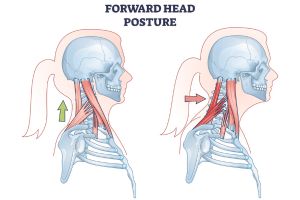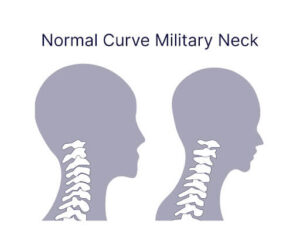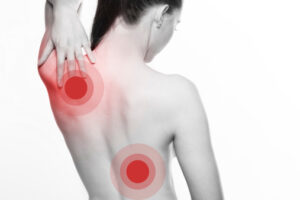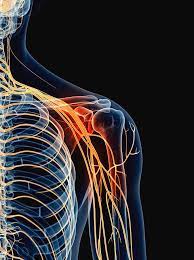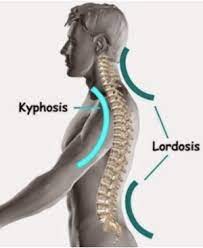

The curvature of the spine is vital for maintaining postural alignment and ensuring musculoskeletal stability.
The cervical spine, which makes up the neck, has a natural lordotic curve—a slight inward curve that helps balance the head’s weight and absorb mechanical stress.
When this curvature is disrupted, as seen in conditions like military neck (cervical kyphosis) or forward head posture, the imbalance has a cascading effect on other parts of the body, particularly the shoulders.
This article explores how poor cervical spine curvature leads to muscle imbalances, altered biomechanics, and reduced stability in the shoulders.
It also presents real-life examples and scientific research to demonstrate the connection between the cervical spine and shoulder health.
In This Article:
- The Role of Spinal Curvature in Maintaining Stability
- Loss of Cervical Lordosis and Its Effects on Biomechanics
- Muscle Imbalances Caused by Poor Neck Curvature
- Impact of Nerve Compression on Shoulder Function
- Real-Life Case Studies
- 5.1. Case Study: Office Worker with Cervical Kyphosis
- 5.2. Case Study: Athlete with Postural Dysfunction
- Scientific Evidence Linking Spinal Curvature to Shoulder Stability
- Conclusion
The Role of Spinal Curvature in Maintaining Neck Stability
The curves of your spine are not just structural—they are essential for keeping your head balanced and your shoulders functioning smoothly.
One small disruption in this elegant alignment can throw off your whole upper body.
Natural Spine Shape & Neck Stability:
Your spine is designed with three graceful curves: cervical (neck), thoracic (mid-back), and lumbar (lower back).
These curves create an “S” shape that helps distribute body weight, absorb shock, and maintain balance. The cervical curve, or cervical lordosis, supports the weight of your head—which weighs around 10 to 12 pounds.
When this curve is properly maintained, your neck, shoulders, and upper back work in sync. The muscles around your shoulder blades stay balanced, and your posture remains upright and efficient.
Why Cervical Lordosis Matters?
A healthy cervical curve plays a critical role in reducing mechanical stress on the neck.
When this curve flattens or reverses—commonly seen in people who slouch or crane their heads over screens—there is an exponential increase in force placed on the spinal discs and joints.
Studies have shown that even slight forward head posture can triple the load on the cervical spine. Over time, this can cause disc degeneration, nerve irritation, and muscular imbalance.
Consequences of Disrupted Curvature:
>>> Muscle Imbalances: Loss of cervical lordosis weakens deep neck stabilizers while overworking surface muscles, leading to neck strain and fatigue.
>>> Shoulder Dysfunction: A forward neck shifts shoulder blade positioning, reducing scapular retraction and causing rounded, droopy shoulders—often called “mom shoulders.”
>>> Headaches and Nerve Pain: Misalignment in the cervical spine increases pressure on upper vertebrae, often triggering cervicogenic headaches and referred pain in the arms.
>>> Postural Compensation: To make up for the imbalance, the mid and lower back may also shift out of alignment, compounding the issue and affecting overall posture.
What the Research Shows?
Multiple studies confirm that healthy adults with intact cervical lordosis display better neck function and reduced pain levels.
Electromyographic studies have found that people with straight or kyphotic (reversed) neck curves have lower activation in shoulder-stabilizing muscles like the rhomboids and trapezius.
Clinical trials show that targeted exercise programs can restore cervical curve and significantly reduce neck and shoulder pain in just a few weeks.
Practical Solutions:
If you suspect you have lost your natural neck curve, the first step is to get evaluated—either by a physiotherapist, chiropractor, or using postural screening tools.
Corrective exercises like chin tucks, wall angels, and cervical traction stretches have been shown to improve cervical curvature and reduce related symptoms.
You can also improve your workspace ergonomics by adjusting screen height and using lumbar and neck support cushions.
Final Thoughts:
The cervical spine is not just a bridge between your head and torso—it is a key player in your overall alignment and comfort.
When its natural curve is preserved, everything from your shoulders to your back works better. When it is lost, you invite a cascade of discomfort and dysfunction.
Catching it early and correcting your posture is one of the smartest things you can do for long-term spinal health.
Loss of Cervical Lordosis and Its Effects on Biomechanics
When the cervical spine loses its natural lordotic curve, two common postural issues occur:
- Forward Head Posture: The head shifts forward, increasing the mechanical load on the cervical spine.
- Cervical Kyphosis (Military Neck): The normal curve flattens or reverses, creating excessive strain on spinal structures.
In both cases, the altered neck curvature causes the head’s center of gravity to shift forward, forcing the shoulders to compensate.
The shoulders round forward and upward, a condition known as protracted shoulder posture.
This misalignment disrupts the normal movement of the scapulohumeral rhythm, the coordinated movement between the shoulder joint and the scapula.
For example, repetitive overhead activities become more difficult as the shoulder joint loses its stability, increasing the risk of impingement syndromes and rotator cuff injuries.
A study published in the Spine Journal (Kawakami et al., 2013) demonstrated that individuals with cervical kyphosis showed reduced shoulder mobility and scapular dyskinesis, emphasizing the biomechanical link between poor cervical curvature and shoulder dysfunction.
Muscle Imbalances Caused by Poor Neck Curvature
Poor neck curvature triggers compensatory muscle activity that destabilizes the shoulders.
Muscles such as the upper trapezius, pectoralis minor, and levator scapulae become tight and overactive to support the head’s weight, while critical stabilizing muscles like the lower trapezius, rhomboids, and serratus anterior weaken.
This imbalance creates a phenomenon known as upper crossed syndrome:
- Tight neck and chest muscles pull the shoulders forward, rounding them.
- Weak upper back and scapular muscles fail to stabilize the shoulder blades, reducing shoulder joint integrity.
The result is chronic muscular strain, decreased shoulder strength, and poor mobility.
Tasks that require shoulder stability, like lifting objects or performing overhead movements, become challenging and painful.
Over time, these imbalances may lead to conditions such as shoulder impingement, rotator cuff tendinitis, and joint instability.
Impact of Nerve Compression on Shoulder Function
The cervical spine houses the spinal cord and nerve roots, which exit the vertebrae to supply the neck, shoulders, and arms.
When the cervical curvature is compromised, the vertebrae may compress these nerve roots, disrupting communication between the central nervous system and the shoulder muscles.
This compression can result in cervical radiculopathy, a condition characterized by:
- Pain radiating from the neck to the shoulders and arms.
- Muscle weakness in the shoulder girdle.
- Numbness or tingling sensations in the upper limbs.
The impaired nerve signals affect the rotator cuff muscles and other stabilizers, reducing their ability to hold the shoulder joint in place during movement.
A study published in Clinical Spine Surgery (Lee et al., 2016) highlighted how cervical misalignment increases nerve root compression, leading to shoulder instability and muscle dysfunction.
John with Cervical Kyphosis
John, a 40-year-old software developer, spent years working at a computer with poor posture.
His forward head position led to a loss of cervical lordosis, resulting in chronic neck pain and shoulder instability.
He noticed weakness when performing simple tasks like carrying groceries or lifting his arms overhead.
A physiotherapist diagnosed him with cervical kyphosis and scapular dyskinesis caused by muscle imbalances.
Through a combination of postural exercises, cervical alignment correction, and scapular stabilization techniques, John regained shoulder strength and mobility, significantly reducing his pain.
Emily with Postural Dysfunction
Emily, a 28-year-old volleyball player, developed shoulder instability that affected her performance.
Analysis revealed that her military neck posture was straining her upper trapezius and levator scapulae, causing poor scapular control.
By addressing her cervical alignment through targeted physiotherapy, posture correction, and shoulder stabilization exercises, Emily restored her shoulder mechanics.
She returned to competitive play without pain or weakness, emphasizing the critical role of cervical curvature in athletic performance.
What does Science Say about Spinal Curvature and Shoulder Stability
The connection between cervical spine alignment and shoulder function is well-documented through multiple scientific studies, emphasizing the biomechanical relationship between these regions.
A 2013 study in the Journal of Orthopaedic Science revealed that a loss of cervical lordosis directly contributes to shoulder dysfunction, particularly impacting movements that rely on scapular stability, such as overhead lifting or reaching.
Similarly, research published in Clinical Biomechanics (Falla et al., 2007) highlighted that forward head posture increases activation of cervical and shoulder muscles, including the upper trapezius and levator scapulae.
This excessive activation leads to muscle fatigue, reduced strength, and instability, impairing overall shoulder performance.
Further, a study in Musculoskeletal Science and Practice (Alpayci et al., 2017) demonstrated that correcting cervical alignment positively impacts scapular positioning and improves shoulder muscle strength, reinforcing the critical role of posture in musculoskeletal health.
These findings collectively underscore the importance of preserving the natural curvature of the cervical spine to ensure optimal shoulder stability and function.
Takeaway
The natural curvature of the cervical spine is essential for maintaining postural alignment and ensuring shoulder stability.
When poor neck curvature develops—whether through forward head posture, cervical kyphosis, or structural misalignment—it disrupts the biomechanics of the shoulder girdle, leading to muscular imbalances, nerve compression, and joint instability.
Real-life cases of office workers and athletes demonstrate how cervical misalignment can impair shoulder function, while scientific research confirms the direct relationship between spinal curvature and shoulder health.
Include shoulder stretches to fix text neck and avoid unnecessary pain.
Recognizing the importance of proper cervical alignment and addressing postural deviations early can help individuals reduce pain, improve shoulder stability, and prevent long-term dysfunction.
References:
